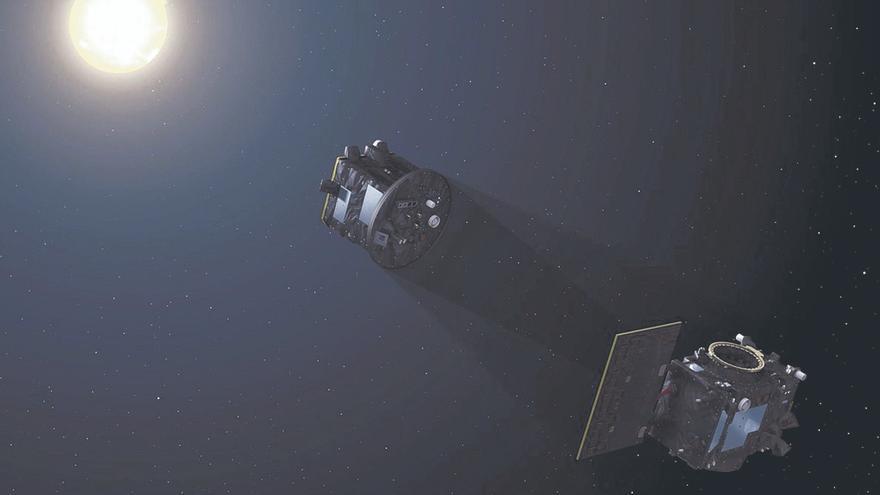In the clean room where the pair of satellites are located, technicians work with great care. It’s like an operating room, a place that needs to be spotless. In some warehouses on an industrial estate near Antwerp, two Proba-3 satellites are being inspected point by point. A work-like point Sleek metalwork ahead of its September launch from India.
Proba-3 is one of several projects of the European Space Agency (ESA), but one of the few led by Spain and Belgium. The main contractor is Spanish engineering company Senor – founded in the Basque Country in 1956 but operating in Catalonia and Madrid – which heads a group of 29 companies from 17 countries that have been developing the project for more than ten years. It is now in the final stages before launch, and they have decided to invite the European media to visit the ships at the facilities of Redwire, the Belgian company responsible for avionics and operations. These days they are working on the last tests.
Experts and scientists describe in detail the characteristics of satellites, their qualities and their activities when they orbit the earth. “Because many of us work professionally at ESA and its collaborators,” explains Esther Bastida, a very young aeronautical engineer employed by ESA who specializes in space issues. Its facilities in Holland and who fully participates in this project.
Scientists hope that Proba-3 will enable a more thorough study of solar storms, sudden changes in the star’s surface that affect our planet’s communications and other functions. This is the first time that two satellites have formed and traveled 144 meters apart, allowing one to receive a signal from the Sun and the other to cover a solar eclipse. A coronagraph satellite carries a coronagraph, an instrument that points directly at the Sun. A second satellite, Occulter, eclipses the Sun and places itself between the star and the coronagraph. They weigh 350 kg and 200 kg respectively. In that way, Scientists can study the Sun The same effect as an eclipse and without the need for it to occur naturally. For them, studying the solar corona is transcendental because space meteorology originates there.
This is the first time in history that two satellites fly at the same distance as one large solid structure. In addition, they will get closer to the edge of the Sun than has been possible until now – 60,000 kilometers from Earth – for a maximum of six hours in each orbit, which will last approximately 19 hours. For ESA representative Dietmar Pilz, the task is “extremely challenging from a technical point of view, as it will require unprecedented precision.”
That aircraft requires additional effort in both design and programming. In this sense, José Julián Echevarría, General Director of Ceneril Aerospace and Defense, said, “This is a great example of industrial collaboration. This milestone is the result of more than 25 years of work in guidance, navigation and control systems.
The satellites are built and planned by Airbus Spain About 170 million euros were awardedThis is usually a relatively small amount for very large spatial investments.
Now there are many interested nations in the universe. The best-known agency is NASA, but there are also programs in Russia, China, Japan, and India. We must add the personal initiative of Elon Musk and his SpaceX, some satellites are often easily visible, while at other times they attract attention, as they did a few weeks ago in the Spanish Mediterranean Sea.
As a result, the sky is full of all kinds of satellites orbiting the Earth, and according to one of these Antwerp experts, “they are a real headache, especially those in low orbit, because they often threaten to collide. “They also create more space debris. Despite its enormity, planetary spacing would require rules to avoid confusion.
As experts continue to calibrate the two satellites and computer scientists develop advanced technical solutions with surgical precision, the audience brings an enthusiasm that these experts, in addition to their immense technical knowledge, marvel at its freshness and naturalness. Send them their findings. Creative engineers.
7.7 billion more
Created in 1975, the European Space Agency covers a total of 22 countries, including Spain, and is headquartered in Paris, managing a budget of 7.79 billion euros. Spain, which joined in 1979, contributes approximately 5.8% of the total. A significant part of that money goes back to the Spanish industry, as is happening now, for example, with Proba-3, led by our country. As of 2019, Spain led two other missions, the SMOS Earth observation satellite, launched in 2009, which studied moisture on continents and salinity in oceans, and the Cheops exoplanet search telescope.

